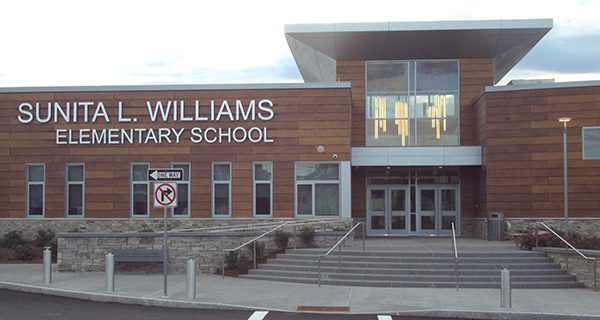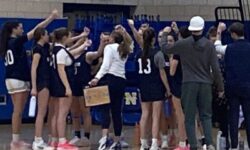[ccfic caption-text format="plaintext"]
By Shelly Santaniello
Hometown Weekly Correspondent
The Sunita L. Williams Elementary School has opened. This is a significant event for the town. Needhamites probably can’t help but be impressed with the big, beautiful structure as they drive by. They may wonder what it looks like inside, how many lucky students will attend, and how it will affect the traffic flow on Central Avenue.
But do they also wonder how the school was named and the significance of that decision?
Sunita L. Williams Elementary is the first school in Needham named after a woman. There are eight public schools in Needham. Four are named after men, two are named after geographic features, one, Needham High School, is named after the town, and one is now named after a famous female astronaut.
Often, schools are named for important political figures. For example, in the decade following their assassinations, many schools were named after John F. Kennedy, Jr. and Martin Luther King, Jr.
Sometimes, schools are named after educators, some famous on a local level, and some on an national level, such as Horace Mann. (Mann, a great education reformer, was born in 1796 in Franklin, Massachusetts. Over 50 schools across the U.S. are named after him.)
So, who were the two local educators who have Needham schools named after them?
Newman Elementary School is named after Dr. Derwood A. Newman, who was Superintendent of Needham Public Schools from 1944-1960. The school opened in 1960 as a junior high school. After housing the state police barracks, Newman became an elementary school in 1993.
Pollard Middle School is named after William F. Pollard. He was the principal of Needham High School from 1927-1956. Pollard was built in 1958.
Two other elementary schools are named after local men. Mitchell School, which opened in 1951, is named after Dr. William Mitchell. Mitchell was born in Canada in 1872. He came to Needham in 1897 after graduating medical school and devoutly served his Needham patients until his death in 1949. This beloved doctor was also very active in the community. He served as the director of the Board of Health, as a trustee of Glover Memorial Hospital, and as a member of Town Meeting and the School Committee.
The Eliot School is named after Reverend John Eliot, whose name dates back to Needham’s early history. Reverend Eliot converted the local Indians to Christianity in the mid to late 1600s. He was instrumental in setting up separate villages for these “Praying Indians.” One of Eliot’s most notable converts was Nehoiden. This leader of the Massachusetts tribe helped Reverend Eliot translate the bible into the Algonquin language. It was Nehoiden who, in 1680, sold the large tract of land that became Dedham in 1636, and would later become Needham in 1711, and Wellesley in 1881.
Originally, the high school was also named after a local man, Judge Emery Grover. He served on Needham’s School Committee for 23 years. The Emery Grover building, which is now NPS’ administration building, used to be Needham High School. The present high school was dedicated in 1930. There were other Needham schools, which no longer exist as schools, that were also named after local men. Some of these buildings have been knocked down and others have been repurposed. Two examples of notable Needhamites who had former schools named after them are William Carter and Stephen Palmer. The Carter School was named after William Carter, Needham’s famous clothing manufacturer and benefactor. The Stephen Palmer School was named after Needham’s third minister. His “Centennial Sermon” (1811) served as the first written history of the town.
Presumably, Needham’s other schools were named because of the geographic features near, or surrounding them. Hillside School, which opened in 1961, was built next to a hill. (Those who have ever driven up or down West Street during a snowstorm know it can be a rather treacherous hill!)
Broadmeadow School, which opened in 1953, must have been built on a broad meadow. Finally, High Rock School was named after the 240 foot granite rock found nearby in the Town Forest. As early as 1649, this rock was referred to as the High Rock in Dedham land survey records. In his book, “Needham, with Interest” (1981), Raymond F. Bosworth mentioned a long-standing myth that “the High Rock was a station in an Indian smoke signal system which reached from the Blue Hills in the east to Mount Wachusett in the west.” High Rock School has been used for many purposes over the years. It became the sixth grade center in 2009.
When it came time to name Needham’s newest school, a committee was formed. It was comprised of representatives from the School Committee, the Select Board, the Needham History Center and Museum, the Massachusetts Organization of Educational Collaboratives, teachers, and parents. It’s evident, from the schools discussed above, that only someone who’d given much to the town and/or had achieved great things would have a Needham school named after him/her.
On June 6, 2017, the School Committee voted unanimously to name the new school after Sunita L. Williams. Williams graduated from Needham High in 1983. She received a Bachelor of Science degree in Physical Science from the U.S. Naval Academy in 1987. She also received a Master of Science degree in Engineering Management from Florida Institute of Technology in 1995. Williams began her astronaut training program in 1998. In 2006, she was launched to the International Space Station (ISS). Since then, she has returned to the ISS several times. Captain Williams has made seven spacewalks, totaling over 50 hours. She was the first person to run a complete marathon in space. Williams was an official entrant in the 2007 Boston Marathon and completed it in four hours and 24 minutes. Sunita Williams has indeed achieved great things. She’s never been a Needham educator, but through her life’s example, she will teach the town’s students that they can accomplish amazing things with hard work, determination, and a great education.





















